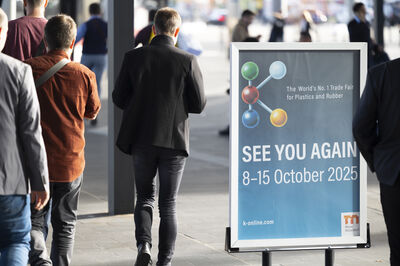K 2025 : Plastics and circularity – caught between necessity and potential

The world is experiencing a raw materials crisis: more than 100 billion tonnes of raw materials are consumed every year, but more than 90% of the raw materials used are not recycled. An alarming figure highlighted by the European Investment Bank (EIB). Rising CO₂ costs, volatile commodity prices and geopolitical uncertainties are putting additional pressure on companies to manage resources more carefully.
Circularity is seen as a key lever for a sustainable future. An analysis by consultancy Material Economics shows that Europe could save 450 million tonnes of CO₂ equivalent by 2030 through closed-loop materials systems - equivalent to 8% of current emissions. In the long term, the Ellen MacArthur Foundation predicts that up to 45% of emissions could be avoided through a closed-loop economy.
There is also huge economic potential in this shift: EY estimates that using secondary raw materials reduces energy consumption by 20-90%, saves large amounts of water and could save European businesses up to €465 billion a year in material costs. The International Labour Organisation (ILO) also expects the transition to a circular economy to create seven to eight million new jobs worldwide by 2030. An increasing number of use cases show that circularity not only makes environmental sense, but also makes economic sense. Germany's Cabka Group, for example, says it produces pallets and crates from around 150,000 tonnes of recycled plastic each year, demonstrating how waste can be turned into valuable products.
Plastics industry: a key sector with catching up to do
The plastics industry has a key role to play in this change. According to Plastics Europe, 413.8 million tonnes of plastics were produced worldwide in 2023, but the share of recycled materials remains low: only 8.7% of plastics were recycled - most of it by mechanical recycling - while the lion's share was incinerated or landfilled. This is despite the huge potential of recycled materials. Their production requires significantly less energy than the production of new products from fossil resources, which significantly reduces carbon emissions. In addition, their use increases security of supply - a factor of increasing importance in times of geopolitical crises.
However, recycling is technically challenging - and often more expensive than producing new plastics. After all, post-consumer plastics have to be sorted, cleaned and processed. In addition, legal requirements are strict, high-quality recyclates are scarce and many processes are energy-intensive - all of which results in higher production costs compared to new plastics. "But nobody wants to pay higher costs," says Ulrich Reifenhäuser, Chairman of the K Advisory Board. "Plastics are so successful because they are so much better than other materials. But the transition to a circular economy costs money. This cost issue will not be solved without regulatory requirements".
However, the answers to the question of how the transition to a functioning circular economy will work vary from country to country.
Europe has its eye on regulation
While other countries focus on voluntary commitments and market-based solutions, Europe regulates through legislation. Policies such as the Circular Economy Action Plan (CEAP) and regulations such as the Packaging and Packaging Waste Regulation (PPWR) and the Single-Use Packaging Directive (SUPD) drive the transition to circularity through recycling rates, mandatory recycled content and extended producer responsibility (EPR). The PPWR shows how this works: from 2025, single-use PET bottles must contain at least 25% recycled plastic, rising to 30% by 2030. For manufacturers such as Coca-Cola and Nestlé, this means redesigning their supply chains, sourcing high quality recyclate and adapting production - or risk being banned from the market. The SUPD is also having an impact: in Lithuania, the return rate for PET bottles rose from 34% to 92% after the introduction of a deposit system - in just two years. Companies face significant challenges: the limited availability of high quality recyclate, the technical complexity of switching to a recyclable design - not to mention the short deadlines for meeting these often complex requirements.
Chemical ingredients are also increasingly coming under EU scrutiny. The handling of PFAS is particularly controversial, as a ban could make recycling much more difficult - because a lot of plastic waste would then be classified as contaminated and excluded from the circular economy. Wolfgang Große Entrup, Director General of VCI, therefore warns against a blanket ban: “With each individual substance banned in the EU the risk grows that more of our industry players move to less regulated regions. This, however, does not solve the original problem.”
Asia: between advances and structural deficits
Accounting for 53% of global plastics production Asia is the main player – and the main source of plastic waste. While some countries pursue ambitious recycling strategies, others lack the basic infrastructure.
China's recycling offensive: centrally controlled, consistently implemented
Long the world's largest importer of plastic waste, China is now changing course. With its "National Sword Policy", the country has stopped importing unsorted plastic waste and is now pushing ahead with the development of its own recycling structures. The 14th five-year plan focuses on modern collection and sorting systems and promotes both mechanical and chemical recycling. By 2035, the industry should be largely decarbonised and move towards closed-loop materials cycles. This strategy is accompanied by the Circular Economy Promotion Law, which requires companies to take back and safely dispose of certain products, and the establishment of the state-owned China Resources Recycling Group to centrally manage the transformation.
Japan and South Korea: driving technology systematically
Japan and South Korea are among the pioneers in circular economy – not least due to clear political objectives and early-adopted legislation. In Japan the “Container and Packaging Recycling Act” has already obliged companies since the 1990s to participate in return and recycling systems. This is supported by the “Plastic Resource Circulation Act” adopted in 2022, which promotes recyclate use and prescribes detailed recycling plans for plastic products.
South Korea pursues a systemic, technology-driven approach via its new “Act for Promotion of Transition to a Circular Economy Society” (APTCES): binding recycling rates, clear requirements for sustainable product design as well as targeted regulation for hard-to-recycle products. In addition, companies wanting to place new recycling technologies on the market, are temporarily exempted from restrictions.
Unlike Europe, these two countries are banking on clear responsibilities, hands-on implementation and targeted innovation funding rather than detailed regulation. This approach is supported by high social acceptance and responsibility assumed across the board when it comes to waste separation and saving resources, for example.
From India to Indonesia: why the circular economy is faltering
In India the “Plastic Waste Management Rules” (PWMR) oblige companies to take back plastic waste. Despite this important step insufficient infrastructure and the varying regional applications of the rules remain a major challenge for a nation-wide implementation. Similar problems exist in Vietnam, where an EPR law was introduced in 2022. It holds manufacturers and importers accountable for seeing to the recyclability of their products.
In Thailand the “Plastic Waste Management Roadmap 2030” pursues the aim of recycling or energetically using 100% of plastic waste by 2027. There are local initiatives in Indonesia but there is no comprehensive national strategy. One objective is to drastically reduce the plastic waste that ends up in the sea by 2040.
Despite the progress made in these countries the regional fragmentation of waste management and the lack of infrastructure continue to pose a major challenge. Raising people’s awareness and stronger industry involvement will make or break the success of these measures.
North America: a patchwork of strategies
In North America circularity strategies are heavily fragmented. The US is pursuing an approach that comprises both state initiatives and private business measures. 33 US states have established EPR programmes, which oblige manufacturers of single-use packaging to financially participate in waste management. By 2032 100% of packaging is to be recyclable or compostable, and 65% of one-way packaging be recycled. Other states, however, lag behind. There is also another reason why plastic recycling in the USA only has a low uptake compared to the rest of the world, despite modern recycling technologies: “There is neither a national nor a state-wide recycling programme that would cover at least a complete federal state. Instead, individual cities and municipalities decide whether, how and which waste they collect and sort,” explains the German federal economic promotion agency, Germany Trade & Invest (GTAI).
Canada pursues a more comprehensive approach to promote the circular economy. The government has introduced the “Federal Plastics Registry”, a national registry for plastics to collect data about the production, use and disposal of plastics. It is designed to increase transparency and make for more effective plastic management. The “Action Plan on Zero Plastic Waste” aims to reduce plastic waste and establish a circular economy for plastics. It includes measures for reducing single-use plastics and promoting reuse and recycling. Beyond this, a gradual approach is pursued to reduce plastic waste by banning single-use plastic products and introducing EPR.
South America has a long way to go
In South America, the circular economy is still in its infancy - around 90% of waste ends up in landfills and recycling is of secondary importance. Chile, Colombia and Brazil have national take-back and circularity schemes, such as Chile's Ley REP, Colombia's Basura Cero initiative or voluntary industry solutions in Brazil. Uruguay's Integrated Waste Management Law (Ley 19.829) promotes integrated waste management and the recycling of packaging. However, despite various advances and initiatives, infrastructure remains inadequate in many regions of South America and success will depend on further government investment, international cooperation and greater public awareness.
Looking ahead
The circular economy is both an obligation and an opportunity for the plastics industry. Europe is taking a strictly regulatory approach, Asia is combining government regulation with technology pushes, while in the Americas the spectrum ranges from ambitious requirements to a patchwork of isolated measures or reliance on the invisible hand of the market.
But each circular economy model has its pitfalls: regulation creates clear rules, but can also lead to excessive bureaucracy and a lack of investment - a risk that is becoming increasingly apparent in Europe. "To avoid slowing down the transformation, we urgently need measures to make investment in the production of circular plastics more attractive, to cut red tape caused by excessively long authorisation procedures, to name but one, and to return to a level playing field with our international competitors," warns Virginia Janssens, CEO of Plastics Europe.
Market-based approaches encourage innovation, but do not guarantee widespread implementation. Centrally controlled strategies produce rapid progress but run the risk of being inefficient. One thing is clear: without higher recycling rates and more recyclates, the circular economy will remain a patchwork. Those who learn from each other can combine strengths and compensate for weaknesses.
Shaping the Circular Economy at K 2025
At K 2025 enterprises from the different sectors of industry – raw material production, machine building and processing – will flag up the major advances made so far as well as coherent future solutions for the circular economy under the guiding theme “Shaping the Circular Economy”. The numerous K Specials will also pick up on the topic, first and foremost the VDMA Dome. The VDMA (German Machinery and Equipment Manufacturers’ Association) will again host an extensive Forum on the outdoor premises in 2025, this time entitled “The Power of Plastics”. With 12 of its member companies it will demonstrate live on the premises between Halls 10 and 16 just how important technology is for implementing circularity in the plastics industry. In the official Special Plastics Shape the Future in Hall 6, organised by Plastics Europe Germany, the discussion forum on Thursday, 9 October, will come under the motto: “Circular Thursday: Transition – Resilience of the industry – which technologies will make the circular economy work?”
For more information on the Circular Economy go to: Circular Economy: Future of the Plastics Industry | K Trade Fair

